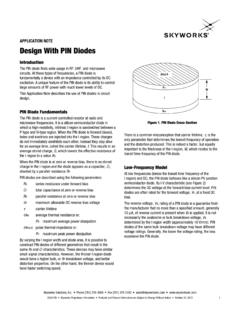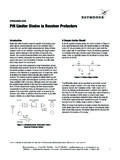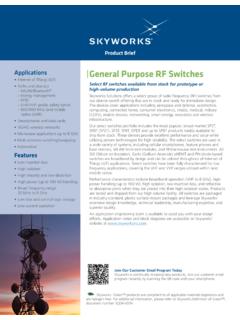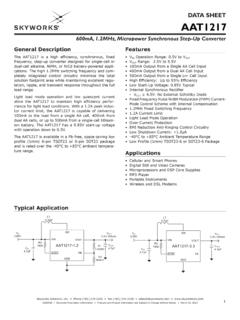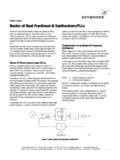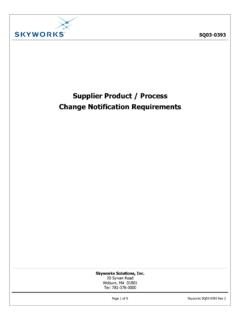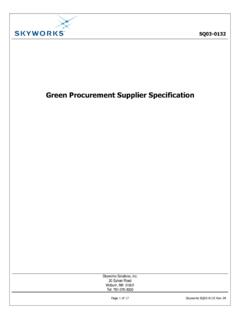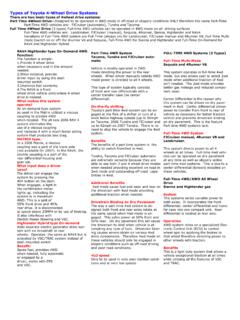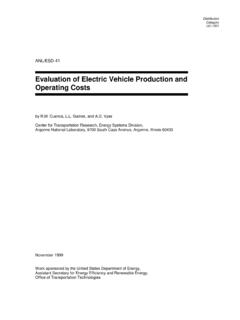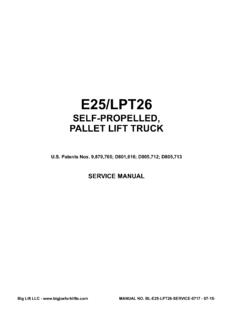Transcription of Isolation in Electric Vehicle Systems
1 Quick Reference GuideIsolation in Electric Vehicle | Smart. Connected. Energy-Friendly. | Isolation in Electric Vehicles | August 2019 Table of Contents Introduction to Isolation in Electric Vehicle Systems EV Isolation Quick Reference Documents Isolation in EV Battery Management Systems Isolation in EV DC-DC Converters Isolation in EV On-Board Chargers Isolation in EV traction Inverters Conclusion | Isolation in Electric Vehicles | August 2019 Introduction to Isolation in Electric Vehicle Systems Automotive OEMs across the globe are announcing aggressive plans to launch new models of battery Electric vehicles (BEVs), plug-in hybrid Electric vehicles (PHEVs) and full-hybrid Electric vehicles (FHEV). Both BEVs and PHEVs are experiencing double-digit growth rates. BEVs bring smooth, quiet, emissions-free transportation to the market. PHEVs add performance and luxury tiers with range extension capabilities and all- Electric drive modes.
2 FHEVs continue to enhance fuel economy and quell concerns with range anxiety since they use traditional petroleum-based fuel sources. As automotive designs move to electrification, high-wattage power electronics become critical components in the new electronic drivetrain and battery Systems . These high-wattage electronics need to be communicated with and controlled by low-voltage digital controllers requiring electrical Isolation of the low-voltage side from the high-power system. In these applications, galvanic Isolation , usually semiconductor-based Isolation , is required to allow the digital controllers to safely interface with the high-voltage Systems of a modern EV. EV System Overview To be competitive with traditional ICE vehicles, the batteries used in EV/HEVs must possess very high energy storage density, near zero self-leakage current and the ability to charge in minutes instead of hours. In addition, the battery management and associated power conversion system must be of minimal size and weight and sip battery current while delivering large amounts of high-efficiency power to the Electric motor.
3 Modern EV/HEV designs use modular components in the drive train and energy storage/conversion Systems . EV/HEV battery management Systems typically include four major circuit assemblies: Battery management system (BMS): Battery cells are monitored and managed by the BMS to ensure high efficiency and safety. The BMS controls the charge, state of health, depth of discharge and conditioning of individual battery cells. DC/DC converter: The dc/dc converter connects the high-voltage battery to the internal 12 V dc network, which also provides power to the accessories and bias to the local switching converters. On-board charger (OBC): Energy storage is provided by Lithium-Ion batteries charged by an onboard charger consisting of an ac-to-dc converter with power factor correction and supervised by a battery management system. traction Inverter: The main inverter drives the Electric motor and is also used for regenerative braking and returning unused energy to the battery.
4 In this reference guide, we discuss system overview, including Isolation requirements. In addition, we include recommendations from our portfolio of automotive Isolation solutions for BMS, DC/DC, OBC, and traction inverter applications. *Please note that this guide contains references to some products that are in development. Please check with your Silicon Labs sa les or distributor contacts for specific product status. | Isolation in Electric Vehicles | August 2019 Isolation in EV Battery Management Systems EV BMS Isolation Quick Reference Battery Management Systems (BMS) are used to monitor and control power storage Systems , assure health of battery cells, and deliver power to Vehicle Systems . Isolation products have numerous uses inside BMS in the electrical domains of Electric Vehicles (EV) or Hybrid Electric Vehicles (HEV). BMS Overview The Systems in an EV are shown below. There are numerous modules that use Isolation such as: on-board chargers (OBC), BMS, dc-dc converters, traction inverters, engine control units, braking Systems , transmissions, and heating/cooling units.
5 The BMS manages stored power in an on-board high voltage (HV) battery and delivers power to the rest of the Vehicle . The main functions include cell balancing, cell health and wear leveling, charge and discharge monitoring, and safety assurance. All these functions require galvanic Isolation to separate lower voltage Systems from high voltage domains. BMS Module EVs utilize BMS for the main battery-based power supply, and HEVs use BMS for battery-side portion of power, complimentary to the internal combustion engine (ICE). BMS monitors the voltage, current, temperature, and wear leveling of battery cells. Additional functions include monitoring faults, system health, available energy, and remaining useful lifetime. Individual lithium-ion battery cells are in the 3 4V range. They are connected in series to deliver higher voltage, and in parallel to increase capacity.
6 Key Isolation Features for BMS 10+ years of automotive market experience, supporting automotive standards and customer needs Top Isolation provider for OEMs and Tier 1 EV suppliers, over 30 million shipped Automotive-grade ready: AEC-Q100, enhanced manufacturing, and ultra-low defectivity | Isolation in Electric Vehicles | August 2019 To monitor the modules and cells, the BMS may have a centralized architecture, or a distributed/modular architecture consisting of a BMS master and several remote BMS units. In distributed BMS Systems , remote units monitoring individual cells may be connected in parallel to the BMS master, or they may be daisy-chained in series. In any case, connections from the battery modules or BMS remote units to the BMS master must be isolated to protect the BMS master from the battery voltages. The diagram depicts a distributed BMS with multiple packs of cells, each with a remote BMS control unit.
7 In this configuration, measurements on cells within the battery modules are made by the remote BMS units and reported over a series connection to the BMS Master controller. Current measurement for the full stack is made using a shunt resistor at the bottom of the stack and an isolated current amp like the Si892x or Si894x. The BMS controller can calculate the voltage of the full stack by summing the voltages of the modules, but a redundant safety-check isolated voltage measurement of the full stack can be made using a resistor divider and isolated voltage sense amp like the Si893x. The entire system can be monitored and controlled via an automotive bus such as CAN. The CAN is isolated with digital isolators like Si86xx and digital isolators with integrated dc-dc power converters like Si88xx. Where Isolation is Needed Voltage: Assure safe and useful battery voltage output o Isolated voltage sensor for the full battery stack Current: Protect batteries from overload or high charging rates o Isolated current sensor monitors discharge and charge current Communications.
8 CAN or serial bus for module data o Digital isolators enable safe and robust communication Isolation Product Offering Summary Family Purpose Family Purpose Si86xx System communication *Si892x Amplifier for Current Shunt Measurement Si88xx Communication with power transfer Si894x Delta-Sigma Modulator for Current Shunt Measurement *Si893x Amplifier for Voltage Measurement * | Isolation in Electric Vehicles | August 2019 Isolation in EV DC-DC Converters EV DC-DC Isolation Quick Reference DC-DC converters are used to convert dc voltages from one voltage domain to another for powering various auxiliary Systems . Isolation products have numerous uses inside dc -dc converters in the electrical domains of Electric Vehicles (EV) or Hybrid Electric Vehicles (HEV). EV System Overview The Systems in an EV are shown below. There are numerous modules that use Isolation such as: on-board chargers (OBC), Battery Management Systems (BMS), dc-dc converters, traction inverters, and heating/cooling units.
9 The main dc-dc converter changes dc power from an on-board 200-800V (HV) battery into lower dc voltages, like 48V or 12V, to power headlights, interior lights, wiper and window motors, fans, pumps, and many other Systems . This high voltage to low voltage (HV-LV) dc-dc converter is often referred to as an auxiliary dc-dc, or Auxiliary Power Module (APM). These functions require galvanic Isolation to separate control Systems from high-voltage domains. DC-DC Converter Module The APM may be in the 2 to 3 kW range with expected efficiency in the 92-95% range when under medium to heavy loading. The return, or ground, for the low-voltage side is normally connected to the Vehicle chassis, so galvanic Isolation between the low-voltage side and high-voltage side is required for safety as well as for protection of the LV controller. Isolation between the HV input and the LV output of the converter is accomplished using a transformer.
10 Switching frequencies can be relatively high ( 100 kHz) to keep transformer magnetics sizes minimal. In some applications like an HEV, the dc-dc can be run in reverse to boost the power from a 12V domain to a 48V or HV domain, to assist in starting or to provide backup power. Key Isolation Features for dc-dc converters 10+ years of automotive market experience, supporting automotive standards and customer needs Top Isolation provider for OEMs and Tier 1 EV suppliers, over 30 million shipped Automotive-grade ready: AEC-Q100, enhanced manufacturing, and ultra-low defectivity | Isolation in Electric Vehicles | August 2019 The APM depicted uses a full bridge on the high-voltage primary side of the transformer, and a full-bridge synchronous rectifier on the low-voltage secondary side of the transformer. The HV switches are often implemented as fast IGBTs (as shown) or high-voltage MOSFETs; the HV switches on the primary side of the transformer require isolated gate drivers.

